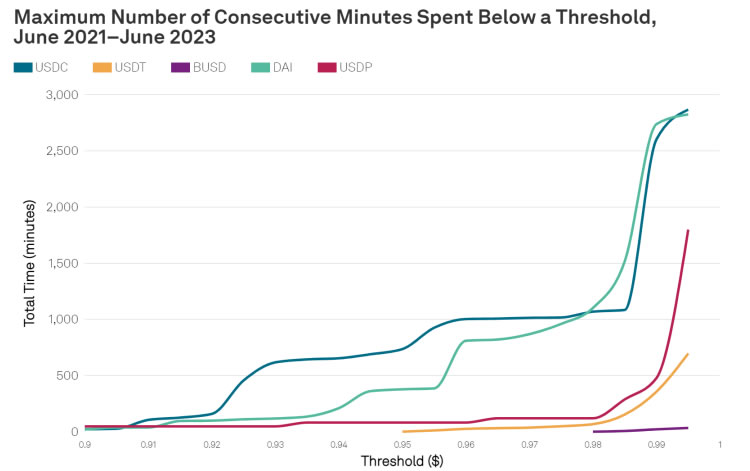According to S&P Global analysts, dollar-pegged stablecoins are not immune to depegging, but some, such as Circle’s USD Coin and MakerDAO’s Dai, are more susceptible than others.
In a September research paper, Drs. Cristina Polizu, Anoop Garg, and Miguel de la Mata delved into stablecoin valuation and depegging for the five prominent stablecoins Tether (USDT), Binance USD, Paxos (USDP), USDC, and DAI.
In the past two years, the analysis revealed that USDC and DAI have spent more time below one dollar than USDT and BUSD. During the longest and most severe de-peg event, USDC was below $0.90 for 23 minutes, while DAI was below $0.90 for 20 minutes.
Nevertheless, USDT fell below $0.95 for only one minute, whereas BUSD never fell below $0.975 between June 2021 and June 2023. In addition, the frequency of de-pegging was significantly higher for USDC and DAI than for USDT and BUSD over two years.

The researchers observed that one-minute de-peg events “can be attributed to noise,” particularly for $1 thresholds. Longer de-peg events were deemed “more meaningful”, but the results still favored USDT over USDC.

The USDC fell to $0.87 in March 2023 due to the failure of Silicon Valley Bank. SVB held $3.3 billion of USDC issuer Circle’s $40 billion USDC reserves at the time.
MakerDAO was one of the largest stablecoin holders at the time, with over 3.1 billion USDC in reserves collateralizing de-pegged DAI.
“Maintaining the peg and a stabilization mechanism requires good governance, adequate collateral, and reserves, along with liquidity, market confidence, and adoption,” Dr. Polizu and colleagues concluded.
Tether has been beset by mainstream media FUD for years, but the data indicates that USDT has been more stable than its competitor, USDC, over the same time frame.
In addition, the USDT supply has increased by 25% since the beginning of the year to 83 billion, giving it a commanding 67% market share among stablecoins.
This has occurred primarily at the expense of Circle, whose USDC supply has shrunk by 41.5% and market share has dropped to 21.0% over the same period.












